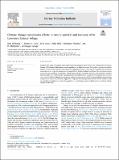Files in this item
Climate change complicates efforts to ensure survival and recovery of St. Lawrence Estuary beluga
Item metadata
| dc.contributor.author | Williams, Rob | |
| dc.contributor.author | Lacy, Robert C. | |
| dc.contributor.author | Ashe, Erin | |
| dc.contributor.author | Hall, Ailsa | |
| dc.contributor.author | Plourde, Stéphane | |
| dc.contributor.author | McQuinn, Ian H. | |
| dc.contributor.author | Lesage, Véronique | |
| dc.date.accessioned | 2021-11-08T16:30:13Z | |
| dc.date.available | 2021-11-08T16:30:13Z | |
| dc.date.issued | 2021-12 | |
| dc.identifier | 276566628 | |
| dc.identifier | 2e091e8c-1bf5-4435-a540-d9418ec3f129 | |
| dc.identifier | 85118129577 | |
| dc.identifier | 000719305700008 | |
| dc.identifier.citation | Williams , R , Lacy , R C , Ashe , E , Hall , A , Plourde , S , McQuinn , I H & Lesage , V 2021 , ' Climate change complicates efforts to ensure survival and recovery of St. Lawrence Estuary beluga ' , Marine Pollution Bulletin , vol. 173 , no. Part B , 113096 . https://doi.org/10.1016/j.marpolbul.2021.113096 | en |
| dc.identifier.issn | 0025-326X | |
| dc.identifier.other | RIS: urn:EC7A6A86A3A8F0414D1BB239CD2D808D | |
| dc.identifier.other | ORCID: /0000-0002-7562-1771/work/102725395 | |
| dc.identifier.uri | https://hdl.handle.net/10023/24288 | |
| dc.description | This study was funded by the Species at Risk programme of Fisheries and Oceans Canada. | en |
| dc.description.abstract | Decades after a ban on hunting, and despite focused management interventions, the endangered St. Lawrence Estuary (SLE) beluga (Delphinapterus leucas) population has failed to recover. We applied a population viability analysis to simulate the responses of the SLE beluga population across a wide range of variability and uncertainty under current and projected changes in environmental and climate-mediated conditions. Three proximate threats to recovery were explored: ocean noise; contaminants; and prey limitation. Even the most optimistic scenarios failed to achieve the reliable positive population growth needed to meet current recovery targets. Here we show that predicted effects of climate change may be a more significant driver of SLE beluga population dynamics than the proximate threats we considered. Aggressive mitigation of all three proximate threats will be needed to build the population's resilience and allow the population to persist long enough for global actions to mitigate climate change to take effect. | |
| dc.format.extent | 9 | |
| dc.format.extent | 988376 | |
| dc.language.iso | eng | |
| dc.relation.ispartof | Marine Pollution Bulletin | en |
| dc.subject | Beluga | en |
| dc.subject | Population viability analysis | en |
| dc.subject | Climate change | en |
| dc.subject | Cetacean | en |
| dc.subject | GE Environmental Sciences | en |
| dc.subject | GC Oceanography | en |
| dc.subject | DAS | en |
| dc.subject | SDG 13 - Climate Action | en |
| dc.subject.lcc | GE | en |
| dc.subject.lcc | GC | en |
| dc.title | Climate change complicates efforts to ensure survival and recovery of St. Lawrence Estuary beluga | en |
| dc.type | Journal article | en |
| dc.contributor.sponsor | NERC | en |
| dc.contributor.institution | University of St Andrews. School of Biology | en |
| dc.contributor.institution | University of St Andrews. Sea Mammal Research Unit | en |
| dc.contributor.institution | University of St Andrews. Scottish Oceans Institute | en |
| dc.contributor.institution | University of St Andrews. Marine Alliance for Science & Technology Scotland | en |
| dc.identifier.doi | 10.1016/j.marpolbul.2021.113096 | |
| dc.description.status | Peer reviewed | en |
| dc.identifier.grantnumber | NE/R015007/1 | en |
This item appears in the following Collection(s)
Items in the St Andrews Research Repository are protected by copyright, with all rights reserved, unless otherwise indicated.

